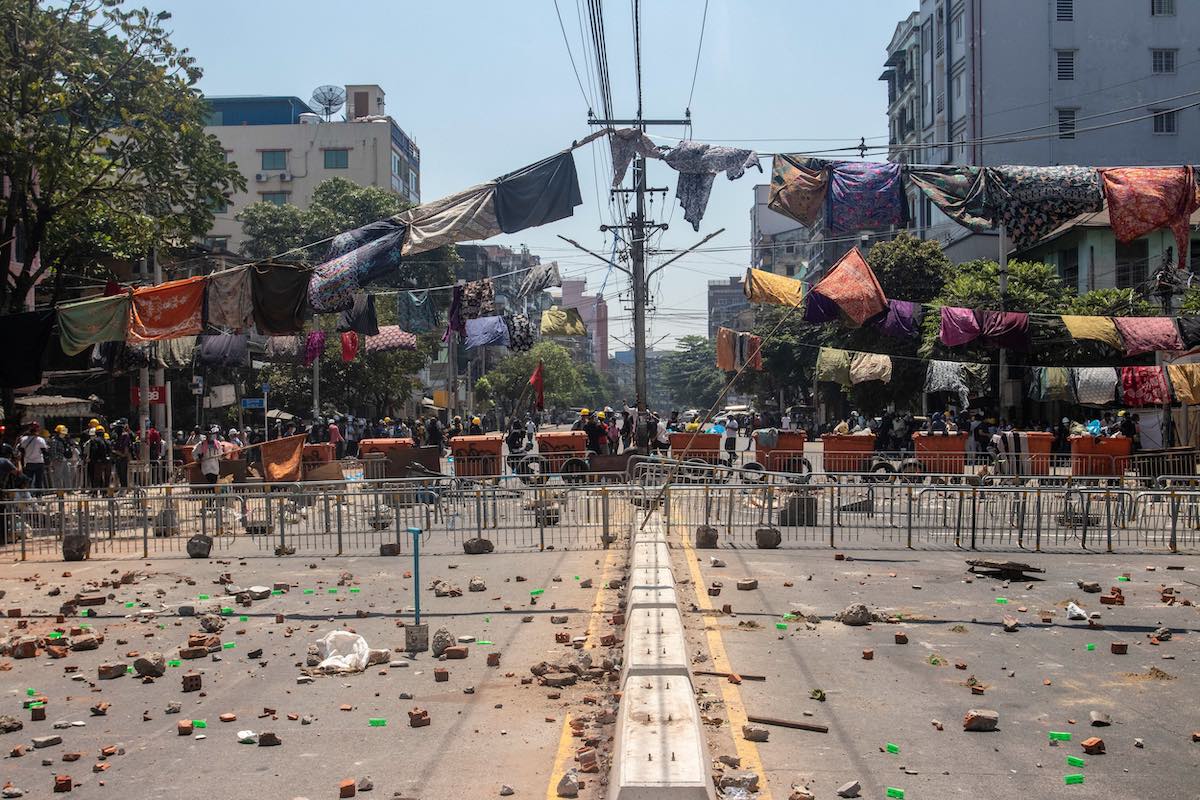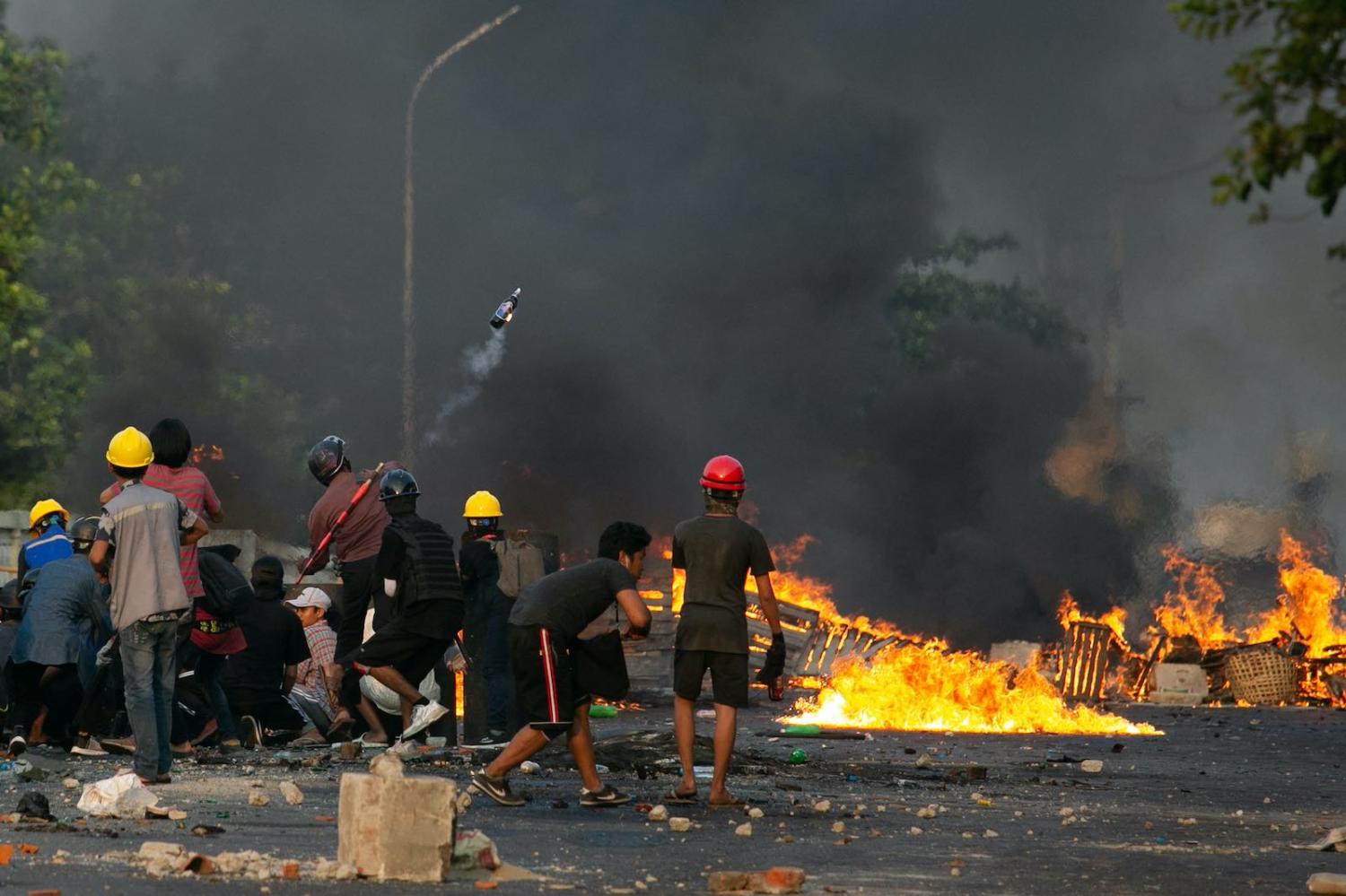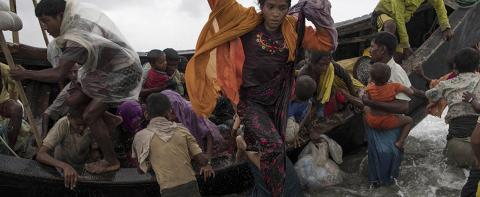The clashes in Myanmar’s streets between largely peaceful protesters and armed members of the security forces over recent weeks evoke memories of similar confrontations in 1974, 1988 and 2007. The result in each of those cases was the brutal suppression of the popular will and a crackdown on dissent throughout the country that lasted years.
So far, the civil unrest sparked by the 1 February military coup has followed a similar pattern, and the eventual outcome looks likely to be the same. However, both sides have clearly learned lessons from the past, and these have been reflected in their tactics.
The initial demonstrations were peaceful, with large crowds marching in the cities, holding printed placards calling for the release of Aung San Suu Kyi and recognition of the National League for Democracy’s landslide election win last November. Other placards depicted coup leader Senior General Min Aung Hlaing, his face disfigured by a large cross.
At night, people banged pots and pans and honked car horns in a symbolic gesture of defiance. A civil disobedience movement has attracted tens of thousands of supporters.
As these efforts were met with increasing resistance from the security forces, barricades were erected on the streets, and defensive measures adopted. Protesters wore plastic construction helmets, goggles and makeshift gas masks. Many carried metal shields or wore improvised protective vests. Protesters began to respond to the tactics of the riot police by throwing rocks and using slingshots to fire pellets and nails.
The protesters also employed psychological measures. They placed pictures of Min Aung Hlaing on the streets, hoping that the security forces would be reluctant to tread on their commander’s image. Women’s clothing was hung on lines across the street, drawing on the traditional belief that anyone walking under them would lose their hpoun, or spiritual power.
The protesters also exploited social media platforms (when not blocked by the regime) and appealed to international opinion (most placards were written in English).

As the level of violence employed by the security forces escalated, the protesters responded. Street barricades became more substantial. Drills were conducted using protective shields. Petrol bombs were thrown at the security forces in some places and fire extinguishers used to obscure their vision. There was an unconfirmed report that protesters were arming themselves with swords and making crossbows, presumably to fire “jinglees” (sharpened bicycle spokes). Such weapons have been used against the security forces in the past.
There have not been any reports of protesters acquiring firearms, but the possibility has been raised by the “defection” of 100 or more policemen. During the 1988 pro-democracy uprising, protesters seized weapons from local police stations and sympathetic members of the security forces. It has been suggested that some of Myanmar’s ethnic armed groups might provide arms to the demonstrators, but this seems unlikely.
To date, the military regime’s response has been calibrated and controlled, but has followed a clear pattern of increasing violence.
The police force’s paramilitary security battalions took the lead in responding to the first demonstrations. They were equipped with helmets, shields and batons. Apart from a few isolated incidents, when shots were fired, they relied on the same non-lethal crowd control techniques that are used in many countries. These included the use of water cannon, tear gas, stun grenades, rubber bullets, pepper balls and possibly beanbag projectiles.
Within a week of the coup, however, these tactics had changed. Increasingly, soldiers were seen on the streets alongside the police, and greater force seems to have been authorised. The security forces became more aggressive in their actions against the demonstrators. There were numerous cases of gratuitous violence, including savage beatings. Martial law was declared in some cities, and soldiers and police started shooting directly at protesters and spectators.
None of these options can bring down a military regime in Myanmar as long as the security forces remain loyal and cohesive.
Claims by the regime that only non-lethal weapons have been used are demonstrably false. From the start of the protests, policemen were seen carrying BA-63 and M-16 automatic rifles, BA-93 submachine guns, shotguns and handguns. Soldiers have been armed with standard-issue infantry weapons, such as the MA series assault rifle. One activist group has claimed that RPD light machine guns have been seen, but this has yet to be confirmed.
Also, from the beginning of the unrest, armoured vehicles have been deployed in an obvious attempt to intimidate protesters.
As Amnesty International recently noted, lethal force is now being used “in a planned, premeditated and coordinated manner”. This seems to be part of a campaign of terror aimed at deterring protests of all kinds. Civilians have no defence against military-grade weapons, even the obsolete firearms issued to the police force. By some estimates, more than 235 protesters have been killed, and an unknown number wounded.
The military regime has also been trying to eliminate the leaders of the opposition movement, where they exist, and weaken its organisation. Snipers appear to have been employed to kill protesters deemed particular threats. With the help of the country’s intelligence agencies, and utilising modern surveillance technology, other key figures, including journalists and opinion makers, have been identified and arrested, usually in night-time raids. Reportedly, more than 2300 people have been detained since the coup.
Given this upward spiral of violence, the protesters’ options are limited. They can return to their homes and adjust to the harsh reality of another military government. They can resort to greater violence themselves, and face a disciplined, well-armed military organisation that has no compunction in crushing all signs of opposition. Or, as occurred in 1988, they can flee to Myanmar’s borders, to become refugees, join an existing armed group or try to set up their own government in exile. Indeed, this is already happening.
History has shown, however, that none of these options can bring down a military regime in Myanmar as long as the security forces remain loyal and cohesive. Foreign intervention is a remote prospect, and in any case is unlikely to be effective. As one observer recently noted, the regime has the power to ratchet up the level of violence even further and enforce its will over the civilian population, but the question has to be asked, at what cost?

